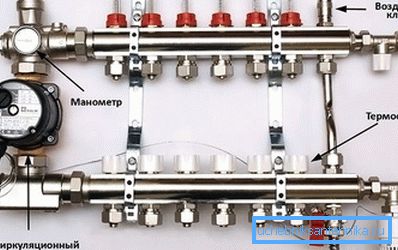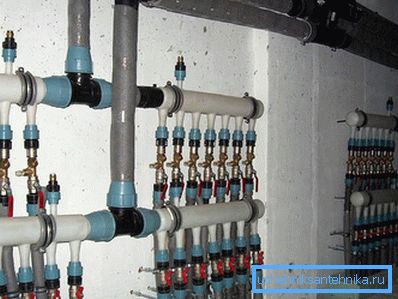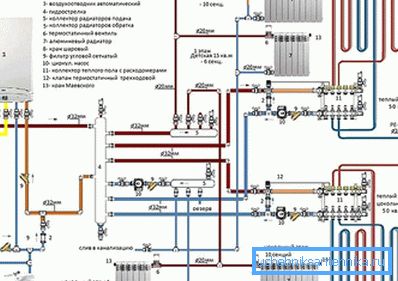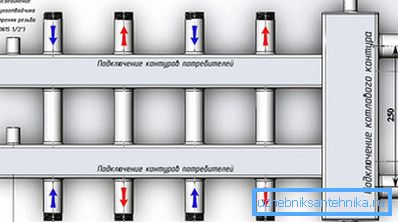Distribution manifold heating itself
An effective home heating system is a very important factor in the comfort of living in a house. The uniform heating of all heating devices means its proper operation. But sometimes it turns out that the coolant is not enough for all the points of analysis. This happens for many reasons, for example, due to non-observance of pipe diameters during installation of the system or incorrect heating installation scheme. It turns out this way: the temperature is sufficient, there is water in the system, and there is not enough heat, because all the batteries simply lack the correct distribution of water. This means that the basic rule for the selection of pipe diameters has been violated: the sum of the diameters of all heating circuits must be equal to or slightly larger than the diameter of the outlet from the boiler. In this case, either using the valves on the batteries, you need to adjust the flow of coolant to the heating system, or it should be redone. One of the solutions to the problem is to make a heating distribution collector with your own hands.
Principle of operation

You can correct the mistakes of previous installers of heating by applying one of the classic connection diagrams. To date, the most efficient distribution system of the coolant in the heating system is a distribution manifold.
At its core, this is a tank into which heated water is supplied from the boiler for heating. From it through pipes of smaller diameter it flows to the point of analysis (heating radiators, heated floors, indirect heating boiler). Having given off heat, the water is returned back through the same pipes, but already to another same capacity (receiving), and then the general flow returns to the boiler. The cycle is complete.
How to alter the heating system

Having skills in handling tools, welding machines (if welding is necessary) and knowledge of plumbing, it is quite simple to make a distribution manifold for heating. First you need to decide on the number of heating circuits. These are separate branches that heat specific rooms (one or more).
If you install a collector in individual heating of two or more storeyed houses, then on each floor it is better to make your own comb (distributor). In this case, you can not do without the boiler room, in which the main distribution manifold will be located.
If the house is single-storey, it is advisable to make one distribution node, which will be located next to the boiler. To take everything into a separate room or combine it, say, with a kitchen - this decision is made on the basis of the layout and size of the house, the model of the boiler and the type of fuel on which it works.
In the case of installation of a heating distribution manifold directly next to the boiler, it is made of metal pipes of circular or rectangular cross section. But before starting work, you should determine the number of points of analysis of the coolant. The choice of the diameter of the pipes to be laid depends on this. After that, for clarity, you need to draw a drawing. It shows all the necessary dimensions and parameters:
- The diameters of the flow and return pipes, branches to the heating circuits, threads.
- Distances between the giving and receiving branches.
- The distances between the main supply and return pipe.
- Direction taps. They can be directed in opposite directions or upwards. If the feed and return taps are directed in one direction, then they are placed in a checkerboard pattern.
When all the necessary preparations have been made, you can proceed to work.
Boiler room

The boiler room collector is made of two dies: supply and return. Of course, for a large house, due to the impressive volume of heat carrier and the considerable length of the heating system, pipes with a diameter of at least 100 mm are used to manufacture the distribution manifold.
The supply manifold is mounted with valves and circulating pumps, and the return one - only with shut-off valves.
Even in the distribution manifold mounted gauges, thermometers and safety group. Such a "filling" allows, without turning off all the heating in the house, to solve the problems of a separate branch.
When installing there is the following sequence of works:
- In accordance with the drawing purchased pipes (in our case, metal). If necessary, they are cleaned from rust.
- According to the assembly scheme, the pipes are welded by electric or gas welding.
- All welds are cleaned and the design is stained.
- The collector is connected to the heating system and pressurized - check for leaks. Do this by filling with water and leave for some time under pressure.
Local collector

The installation of such a node in its principle is no different from the assembly of a distributor in a boiler room. The exception is pipe material. Since this is, let's say, a redundant node, which is far from the heating device and the temperature effect on it is much lower, then composite PP pipes or from metal-plastic can be used. But soldering is more reliable than a collet connection, so polypropylene pipes are preferable.
The next difference of the local comb from the boiler room is that, since the length of the pipes is small, the water does not have time to give all the temperature and returns to sufficiently hot, and the water in the return flow into the boiler is almost cold.
Profitable or not

How profitable it is to install the heating distribution manifold yourself, judge for yourself. First, you only spend on materials. Secondly, it is fully consistent with the technical parameters of your heating system, while the store collector will still have to be redone for it. And this is also a cost. Thirdly, the collector itself will help to quickly recoup the cost of its installation. How? In a conventional two-pipe heating system, the coolant passes along the contour, giving off heat, say, 20m, and the collector circuit is half as long as goes to a single point of analysis, so the water in the return line is warmer and less fuel is required for heating. And given that the fuel is very, very expensive, then he will pay for himself in one season. If you have questions, write comments to the article. The specialist working on the site will provide you with additional information.
Video
You can learn about how to make a distribution manifold yourself from the video we offer:
Scheme
The following are several collector heating schemes:





